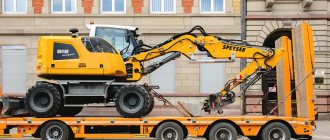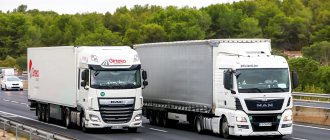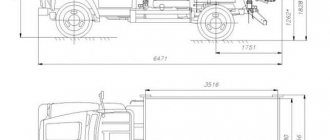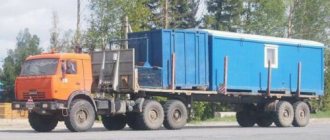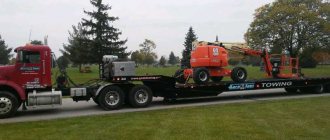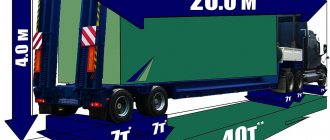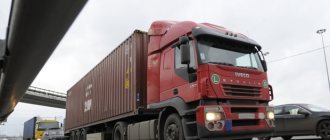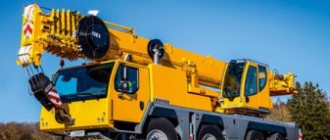A trawl is a special vehicle designed for transporting indivisible and oversized cargo. It is a trailer with a standard or sliding platform having from two to eight axles.
Various construction, military and agricultural equipment are transported using a trawl, including tracked vehicles that are prohibited from moving on public roads
Trawl design
Trawls for transporting special equipment and oversized cargo have a complex design consisting of various components, such as:
- support frame;
- from two to eight axes;
- coupling devices;
- inclined ramps or ramps.
Trailers are equipped with reinforced hydraulic, pneumatic or spring suspension.
All trawl models are equipped with a double braking system. The parking brake installed on 1-2 axles retains functionality without connecting to external energy sources or a pneumatic system. The parking brake lever is activated before the tractor is released.
To transport oversized cargo, trawls can be equipped with various extensions, folding racks, stoppers, special fastenings and other additional elements.
To secure loads, there are belts, chains, cables and other fastening devices. Modern trailers are equipped with ABS and EBS systems, which reduce braking distances and help maintain a given trajectory in difficult road conditions. Anti-lock and traction control systems increase vehicle stability and extend tread life.
When docking a trailer with a tractor, a connection is made between electronics, pneumatics, ABS systems, etc. The mechanical coupling ensures the distribution of loads on the towed equipment.
The axles of some trawl models can be rotated independently, allowing for more precise maneuvers.
SEMI-TRAILERS-TIMBER CARRIERS (LOGO TRANSPORTERS)
Another type of semi-trailers produced are timber semi-trailers (log trucks). TSP timber trucks are available in 2- or 3-axle versions with a maximum load capacity of up to 45 tons. Suspension: pneumatic, spring or spring-balancer axle. The latest type of suspension is easy to maintain and repair, reduces wear on the chassis and ensures a smooth ride.
Mobile bunks and lashing devices are used to secure transported logs. The safety of the driver's cabin from longitudinal displacement of the load is ensured by the front shield.
When choosing a semi-trailer, in addition to technical and design features, it is also important to take into account its equipment. For example, the basic equipment of all models of TSP semi-trailers (low-bed, high-bed off-road, flatbed and timber carriers) includes:
- pneumatic brake Wabco
- Jost support device
- spare wheel lift
- tool box
- fender bars
- lateral protection
- wheel chocks
- retractable extensions
In addition, TSP semi-trailers can be coupled with almost any truck tractors - Kamaz, Iveco, Man, Volvo, etc.
Specifications
The main characteristics of trawls include:
- load capacity – up to 110 tons;
- number of axes – from 2 to 8;
- ground clearance (clearance) – up to 950 mm;
- loading method - rear, front or front;
- overall dimensions: platform length – up to 16 m, width – up to 3.2 m.
Table 1. Comparative parameters of trawls.
| Characteristics | Values for trawls with different numbers of axles/wheels | ||||||
| 2/8 | 3/12 | 4/16 | 5/20 | 6/24 | 7/28 | 8/32 | |
| Load capacity, tons | 25 | 45 | 60 | 75 | 90 | 95 | 110 |
| Trawl weight, tons | 9 | 12 | 14 | 16 | 20 | 24 | 26 |
| Platform length | 10 | 11 | 11 | 12 | 12 | 13 | 16 |
| Width | 2,5 | 2,5 | 2,5 | 2,5 | 2,5 | 3,0 | 3,2 |
| Transport height | 0,5 | 0,8 | 0,9 | 0,95 | 0,95 | 1,05 | 0,95 |
Trawls are designed for use on public roads.
Transportation of oversized cargo.
Loading platform working area
One of the most important parameters of each trawl is the working loading platform. If large-sized special equipment extends beyond the working area, special devices are used - extenders. Using these means, it is possible to expand the trawl platform to 3030 mm. In the non-working position, the retractable extensions are recessed into the platform. In the working position, special wooden beams with impregnation that are resistant to aggressive environments are placed on top of them.
An important type of low-loader trawls are semi-trailers with a sliding frame (platform). Telescope semi-trailers are a universal means for transporting both oversized and oversized cargo or equipment. "Politrans" produces sliding semi-trailers in 2, 3, 4, 5, 6 and 7 axle versions. The maximum frame extension is 7 meters, and the maximum length of the trawl loading platform is up to 20 meters.
Advantages
The advantages of special trailers include:
- reliability due to the manufacture of all components from especially strong structural steel;
- the ability to easily enter and exit the trawl for any transported equipment;
- stability of cargo during transportation over any distance due to high-quality fixing devices;
- good handling and maneuverability;
- modular and sliding telescopic models allow you to place cargo of any non-standard dimensions;
- universal connecting elements are suitable for joining tractors of any model with cargo trawls;
- Convenient ladders or ramps make loading simple and safe.
Thanks to the large number of axles, the loads from the transported goods are distributed evenly on the loading platform without causing damage to the roadway.
Classification
Depending on the type of cargo transported and the route, trawls are selected, which are classified according to various criteria.
By number of axes
The axis is a support that supports the frame with all the units, mechanisms and devices mounted on it.
The number of axles depends on the load capacity. A trailer can contain from one to eight or more axles. The entire load from the frame and the cargo placed on the trailer is transferred to the axles.
The more axes, the more stable the equipment.
By load capacity
Trawls are:
Lightweight, with a lifting capacity of up to 25 tons. The platforms are placed on two or three axes. Designed for transporting excavators, bulldozers, logging equipment, pipes and other cargo.
Medium , with a lifting capacity of up to 45 tons. They have 3-4 axles and pneumatic, hydraulic or spring suspension. They are used for transporting construction or quarry equipment and other goods.
Heavy - with a lifting capacity of 45-110 tons. They have up to eight or more axes. They are equipped with pneumatic, hydraulic, balancing or combined suspensions. Heavy modular trawls allow you to transport cargo of non-standard shapes and large sizes. Used in shipbuilding, defense and oil and gas industries.
Super-heavy - low- and high-frame, assembled from separate modules. The carrying capacity of such heavy trucks can be up to 200 tons. They are used in the defense industry, big energy, oil and gas production and other raw materials industries for transporting heavy equipment: sea vessels, missiles, building structures, drilling rigs, etc.
Transportation of super-heavy equipment must be accompanied by traffic police officers and requires permitting documentation for the transportation of oversized cargo.
Transportation of oversized cargo on a composite trawl
According to the height of the loading area
Platform height is one of the key parameters when choosing a trawl.
- Low-bed trailers are suitable for transporting cargo weighing up to 100 tons: electrical equipment and cable products, special vehicles and materials.
- High-frame ones - have increased ground clearance to 1.25 meters. They are used for operation in harsh climatic conditions and in hard-to-reach areas. They can navigate bad roads and snowy tracks.
Low frame trailers are chosen for transporting goods on public roads, under bridges, power lines and in tunnels. They are suitable for solving any logistics problems.
By suspension type
- Spring. An outdated, least expensive option for rigid mechanical models. The design is based on metal elements (springs) and dampers that dampen vibrations and soften shock loads.
- Balancer suspension is used on multi-axle trailers. Due to the elastic springs located on the suspension axis, the vertical movements of the supporting frame are smoothed out, ensuring a smooth ride and good cross-country ability.
- The combined spring-balancer suspension consists of longitudinal springs connected to each other by a swinging balancer. This design has a high load capacity and reliability, ensuring maximum stability of the trawl on the road. Suitable for both low loaders and high trawls used on public roads and in moderate off-road conditions.
- Air suspension is more often used on modern models. The system allows you to adjust the smoothness of the ride depending on the height and uniformity of the load. Damping is provided by air bags, the pressure in which is maintained by a car compressor.
- Hydraulic suspensions are characterized by reliability and increased load capacity. Most often used on extra-heavy semi-trailers and heavy modular trawls. Equipment with hydraulic suspension has high maneuverability and maneuverability.
With a hydraulic suspension, it becomes possible to increase maneuverability, since it is possible to achieve a wider angle of rotation of the wheels; what it will be depends on the manufacturer. This suspension is of fairly high quality and rarely needs repairs.
The disadvantages of a hydraulic drive include possible loss of performance in harsh climatic conditions due to the possibility of freezing of the working fluid.
Transportation of military equipment.
Differences and design of a high-frame trawl
The high-frame trawl has a slightly different design. The suspension of this semi-trailer is reinforced and can be balanced or pneumatic. The chassis is designed for high loads, the tires are designed for off-road driving. Their number of axes usually does not exceed five. The ground clearance has been increased to ensure that the trawl height from the ground is at least 1 m.
The advantages of high-frame vehicles include:
- good cross-country ability of the vehicle on bad roads and off-road;
- presence of additional sides;
- the possibility of installing cranes and other equipment that simplifies loading and unloading.
The disadvantage of this type of trawls is considered to be lower carrying capacity compared to low-frame models. They are extremely rarely capable of transporting more than 105–110 tons. In addition, due to the large loading height, it is more difficult for transport to pass under bridges or overpasses or drive through tunnels. They are also less stable on the road because they have a high center of gravity.
Types of trawls
Trawls for transporting special equipment and oversized cargo are produced in Russia and abroad in a large number of variations.
Rear-entry semi-trailers
For independent entry of self-propelled vehicles, special ramps are provided at the rear of the semi-trailer.
Devices are:
- hydraulic, one- and two-section, lowered to the working position using a hydraulic drive;
- mechanical ladders of various carrying capacity, lowered manually;
- removable devices made of light alloys, folding into a special compartment located under the platform.
Rear-entry trawls are not suitable for self-loading equipment with low ground clearance.
Rear loading trawl.
Front entry semi-trailers
Conventional rear-entry platforms, with a lift angle of about 20°, cannot be used for independent entry of powerful mining dump trucks, road rollers, asphalt pavers, crawler bulldozers, graders, and excavators.
To load them under their own power, a low-loader trawl with a front entry is used.
To reduce the loading height, such trailers have a stepped design with a detachable gooseneck.
After disconnecting the gander, the front part of the platform lowers to a height of 400-550 mm. After the equipment enters from the ground or attached ladders, the gander is fastened and hydraulics raise the platform to the transport height.
Trawl with front loading.
Sliding semi-trailers
Such designs are able to adapt to the dimensions of the cargo. Sliding telescopic platforms allow you to increase the length of the platform. Depending on the length of the load, the extension of the platform can be single, double or triple and reach 40 meters. Such trailers are used to transport pipes, beams, poles, supports or tanks.
Increasing the length of the platform reduces the carrying capacity of the trawl.
Trailers with low loading height and straight chassis
Low loading height is achieved through the use of small tires and a stepped frame lowered to the level of the wheel hubs. The chassis is located between the axles.
Trailers are suitable for moving small tracked vehicles, self-propelled agricultural machinery, building structures and other cargo on standard roads.
Low-height trawl.
Tilt trailer
The devices have a low loading height due to the inclined frame. Only the central, flat part of the platform is used to place the load. Light-weight equipment can occupy the entire part of the trailer, including the inclined part.
Lightweight trailer with inclined frame.
Modular trawls
Modular trailers have a complex design and belong to the category of low-bed heavy trucks. Dimensions can be increased using special modules that allow you to increase the platform both in length and width.
The design of the modular trawl ensures high maneuverability due to the ability to tilt the installation platform in any direction, and independent adjustment of individual wheel pairs and axle lines.
Modular trawl
Composite trailers
They consist of a loading platform and dolly trolleys with different numbers of axles.
The trolleys have their own fifth wheel coupling device (FDU), which allows them to be uncoupled from the trawl loading platform.
When loading, the trolleys are detached and the main platform is lowered to the ground.
Composite trailers can transport large, heavy equipment. Their load capacity is limited only by the mechanical strength of the supporting frames.
Low-bed
The platform height of low loader trailers ranges from 40 to 70 centimeters from the road surface. The length can reach 13-16 meters. Such trawls are suitable for transporting specialized equipment and oversized cargo on standard paved roads.
High frame trawls
The ground clearance of high-frame trawls can be up to 1.3 meters.
They are used to work in hard-to-reach places, off-road conditions and snowy roads. Suitable for work in harsh climatic conditions.
High-frame heavy-duty trawl
Ballast trawls
Their feature is a powerful frame and a reinforced platform, which allows them to transport extra-heavy loads (containers, construction equipment, wind turbines, etc.).
Trailers are usually equipped with a sliding system that allows you to “hide” extra meters of length.
Ballast trawls are capable of carrying out transportation in different conditions, ranging from standard roads to off-road conditions.
Trawl telescope/telescopic
Telescopic trailers are equipped with a reinforced frame with a reliable sliding mechanism. Pneumatic locks allow sections to be secured in transport position.
Such trawls are capable of transporting long equipment weighing up to 80-100 tons (drilling rigs, ratification columns, turbines and rolling mills, combines and small river vessels, and other cargo).
When assembled, the devices are compact and maneuverable, requiring less fuel consumption when moving to the loading site.
Low loader telescopic trawl.
Front entry trawl
The tilt angle of the folding ladders is about 18˚. Rollers, asphalt pavers, and crawler excavators cannot overcome it. To solve this problem, trawls with entry from the front are used. Their feature is a lower platform height and a detachable gander. Before loading, the gander attached to the SSU is disconnected from the frame. Then the tractor pulls away. The approach angle is small; a grader or heavy bulldozer can handle it.
Transportation Features
Transportation of goods by trawls is regulated by the transport legislation of the Russian Federation and requires coordination with the owners of highways along the route and the State Automobile Inspectorate.
Special permitting documentation of the established form is drawn up.
The speed when loading should not exceed 50 km/h.
Mobile trains transporting goods of non-standard sizes must be equipped with light signaling and installed identification signs “Large cargo” or stickers with a similar inscription.
When transporting dangerous and large cargo, there must be escort by traffic police crews.
Types of loading devices
Loading of transported goods can be carried out in various ways:
- Using drop-down ramps placed on rear- or front-loading trawls. This design is considered outdated and less common. The devices have too large an angle of inclination, which is very difficult for most self-propelled vehicles to drive.
- The most effective and convenient loading devices are ladders with retractable “feet” - ramps. Such devices are of considerable length and provide the required level of inclination, allowing self-propelled vehicles to easily drive onto the platform. The ramp ramp is controlled using a hydraulic or pneumatic drive.
To load cargo onto a trailer, truck cranes with sufficient lifting capacity can be used.
Loading should be carried out in such a way as to ensure uniform axial loading.
Trawl with ramps.
Heavy duty semi-trailer with dolly
Specifications:
| Weight of the equipped semi-trailer, kg: | 7000 |
| Total weight, kg: | 19000 |
| Weight of transported cargo, kg: | 12000 |
| Total mass attributable to: | |
| — front trolley, no more, kg: | 9000 |
| — rear trolley, no more, kg: | 10000 |
| Tires: | 8.25R15 235/75R17.5 |
| Number of wheels: | 8+1 |
| Suspension: | Spring, dependent |
| Maximum speed, km/h: | 60 |
| Entry angle along ramps, degrees: | 14 |
| Diameter of the coupling loop, mm: | 90 |
Vehicles allow you to solve the most complex tasks of transporting your large and heavy cargo.
Main selection criteria
Buyers of trawls are automobile companies specializing in the transportation of non-standard oversized cargo, manufacturers of power equipment, construction and agricultural companies and other enterprises that use trailers to move equipment and special equipment.
The key indicator when choosing trawls is the platform parameters. The number of axles and dimensions directly affect the load capacity.
When choosing, you should consider:
- Cost of special equipment. Models from domestic manufacturers cost significantly less than European cars, while not inferior in technical and operational properties. When purchasing directly from the manufacturer, you will not have to pay intermediary services or trade markups. In addition, you can order machines of non-standard sizes with the required configuration from manufacturers.
- Frame material and quality. The high-quality and durable frame is made of high-strength structural steel.
- Suspension type. Good maneuverability and controllability are provided by pneumatic and hydraulic suspensions. At the same time, when operating in conditions of extremely low temperatures, hydraulics should be abandoned due to possible freezing of the working fluid.
- Safety. The trawl must have a reliable grip on the tractor and high-quality fastenings to secure the load while moving. Retractable ramps ensure safe entry and exit.
- Equipment. An important criterion when choosing a trailer is its configuration. Semi-trailers can be equipped with ramps or attached ladders, retractable extensions, systems for forced rotation of wheel pairs, electronic braking systems and control units, search lights, and compartments for repair kits. Additional equipment will facilitate the operation, repair and maintenance of special equipment.
FLATBOARD SEMI TRAILERS
TSP flatbed semi-trailers are also mainly designed for operation in difficult road conditions with a maximum cargo weight of up to 50 tons and a length of 12 to 14.2 meters. The design and characteristics of onboard trucks make them a universal means for transporting pipe products, reinforced concrete products, machinery and equipment and other cargo.
Their versatility lies in the fact that, thanks to the presence of several slots for the king pin, it can be rearranged and the same semi-trailer can be used with different tractors. In addition, all sides are removable. By removing them, you can transport cargo that significantly exceeds the width of the platform, and, using sliding bunks, you can transport high cargo.
